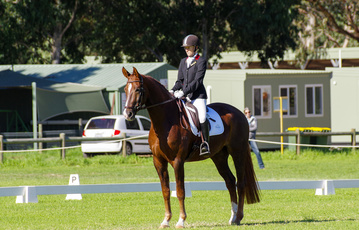
As we discussed last week when we talked about stretching (and how we should all do more of it), it’s pretty important that before we even put a foot in the stirrup as a rider, we prepare our bodies for the task at hand with a dynamic warm-up.
Being in the saddle involves using muscles outside of their natural alignment and creates unique tensions that tend to lead to stiffness in riders. The best thing we can do is to prevent this tension building into a more significant issue by remembering that we are athletes too!
As well as exercises to increase suppleness, it is important to also include a cardiovascular warm up prior to getting on the horse. Given the incredibly high heart rate levels that can be attained while riding - particularly for those who have an intense session planned (galloping, jumping) – and the need to use global and accessory muscles to their maximum, increasing the heart rate gradually is particularly important for injury prevention, as well as getting the most out of the ride or training session.
Being in the saddle involves using muscles outside of their natural alignment and creates unique tensions that tend to lead to stiffness in riders. The best thing we can do is to prevent this tension building into a more significant issue by remembering that we are athletes too!
As well as exercises to increase suppleness, it is important to also include a cardiovascular warm up prior to getting on the horse. Given the incredibly high heart rate levels that can be attained while riding - particularly for those who have an intense session planned (galloping, jumping) – and the need to use global and accessory muscles to their maximum, increasing the heart rate gradually is particularly important for injury prevention, as well as getting the most out of the ride or training session.
The third element in the warm-up process for the rider is ‘waking up’ the relevant muscles with some targeted exercises for the glutes, deep abdominals and obliques. These muscles help to stabilise the rider in the saddle, providing a safe, secure and effective position. They also protect the spine from over-exertion during riding – back injuries being one of the most common injuries amongst riders of all ages and disciplines.
So – you’ve jogged from the house to the yard, lifted your gear to the hitching rail and jogged to the field to bring your horse in…what’s next? Let’s cut straight in to some simple and helpful stretches for the Rider Athlete. And as you can see - you can do it all in your riding clothes, in the middle of a paddock!
So – you’ve jogged from the house to the yard, lifted your gear to the hitching rail and jogged to the field to bring your horse in…what’s next? Let’s cut straight in to some simple and helpful stretches for the Rider Athlete. And as you can see - you can do it all in your riding clothes, in the middle of a paddock!
| Hamstring Stretch Lying on your back, raise one leg as high as you can while keeping your knee straight an your pelvis flat on the ground. Use a theraband, elastic or rolled up towel over the ball of your foot or hold the back of your knee with your arms to encourage your leg towards your torso. Hold for approx. 30 seconds and repeat with the other leg. Advanced – move leg away from your body to stretch inside of hamstring and groin, then move leg across body to stretch ITB and outside of hamstring. Glute Stretch (Pretzel) Lie on your back with both knees bent. Cross one leg over the other so that your foot is on the opposite knee. Bring both knees towards your chest by gently pulling the uncrossed leg. Hold for 30 seconds and repeat with the other leg. Gluteal Muscle and Back Stretch (Twisting) Sit on the floor with one leg bent and the other straight. Turn your body towards the bent knee and apply pressure by using your opposite elbow against the bent leg to encourage your body to twist. You’ll feel a stretch in your glute and back muscles. Hold for 30 seconds and repeat with the other leg. Adductor Stretch Sit on the floor with your knees bent and open to the sides, the soles of your feet pressed together. Straighten your spine and hinge forward from your hips while keeping your seat-bones pressed to the floor. Gently press down on your knees with your hands to encourage more of a stretch. Hold for 30 seconds. Calf Stretch With your arms extended in front of you and your back straight, lean against a wall or fence with your hands. Stretch one leg out behind you and keep the heel pressed firmly to the ground. The other leg is forward in a lunge position to stabalise you. Slowly bend your elbows and lean forward until you feel a stretch through your calf. Hold for 30 seconds and repeat with the other leg. Alternatively – you can find a step, mounting block or edge of the concrete slab and stand with your toe on the edge and your heel hanging off, then slowly lower you heel until you feel a stretch in your calf. Shoulder and Back Stretch Find a low fence or rail approximately hip height and lean forward to hold on to it. With your feet placed slightly away from the fence lean back extending your pelvis out behind you and let your weight hang. Depending on where you place your feet you’ll feel a stretch through your shoulders, back and even hamstrings. Hold for 30 seconds. Hip-flexor Stretch From a kneeling position, bring one foot in front of you and place it on the ground. Keeping your back straight, lean forward into your bent hip and tuck your pelvis until you feel a stretch in the front of your hip and thigh. Hold for 30 seconds and repeat on other leg. |
If any of these stretches are particularly difficult or painful it might be a good idea to head to the physio to have a look at what is going on! As our 76 year old guest blogger Carla says – I beat a hasty path to my physio if I feel something is not right, an injury at any age is a setback, but in old age it can soon become permanent.
Happy stretching – and aim for at least a few sessions a week, or as many days as you ride
Happy stretching – and aim for at least a few sessions a week, or as many days as you ride
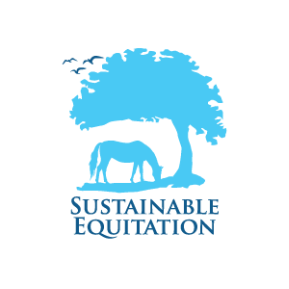
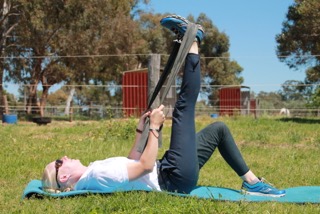
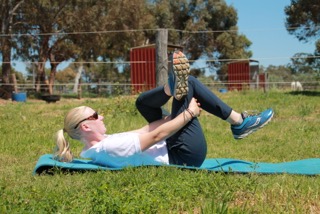
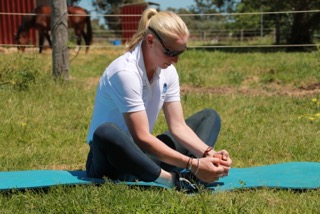
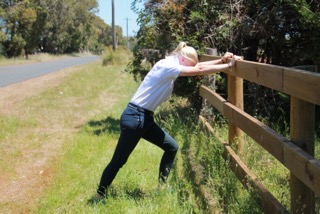
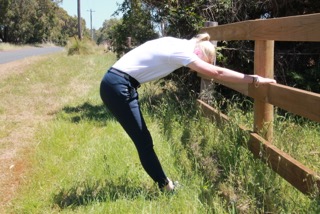
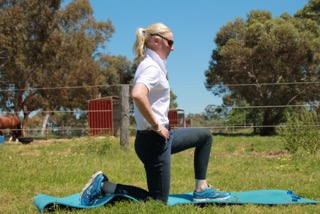
 RSS Feed
RSS Feed
